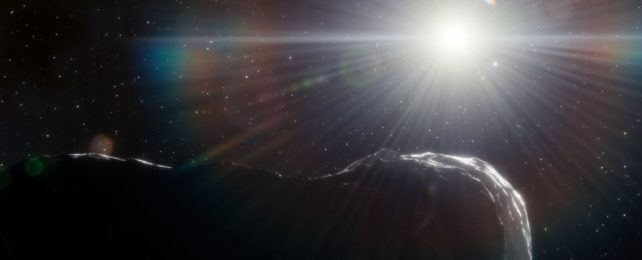Astronomers peering into the twilight sky have found three previously unknown near-Earth asteroids. One of which is the largest potentially hazardous asteroid discovered in eight years.
It measures roughly 1.5 kilometers (nearly 1 mile) across, and is on an orbit that may, in the future, bring it close enough to Earth to pose a problem.
The other two asteroids have paths that are entirely, and safely, closer to the Sun than Earth's orbit. That doesn't make their discovery any less exciting, adding to a census of hard-to-find objects that will allow us to better characterize the population of near-Earth objects.
Most of the minor planets in the Solar System – objects in direct orbit around the Sun that are neither planets nor comets – have been discovered at orbital distances greater than Earth's. There's the asteroid belt between Mars and Jupiter, the Kuiper Belt out past Neptune wherein Pluto resides, and a bunch of other rocks, such as Greek and Trojan asteroids that share planetary orbits.
Not much in the way of minor planets has been discovered closer in to the Sun, and for a very good reason. We have to look towards a big, bright star, whose blinding light makes small, dim asteroids pretty well undetectable. That means we're more likely to find objects when we're looking away from the Sun in a direction that faces the outer Solar System.
To have a chance of spotting an inner Solar System asteroid, astronomers need to wait until the twilight hours at dawn and dusk when the Sun's glare mostly lies below Earth's horizon, providing just enough light to illuminate inner asteroids that might be sweeping through space.
A research team led by astronomer Scott S. Sheppard of the Carnegie Institution for Science conducted just such a search of large patches of the sky nearer to the Sun than Earth and Venus, leading to some fascinating discoveries.
One was 2021 PH27, an asteroid with the shortest orbit of any asteroid found yet, at just 113 days. Then there's 2021 LJ4, which also circles the Sun entirely within Earth's orbit. Both are known as Atira asteroids.
"So far we have found two large near-Earth asteroids that are about 1 kilometer across, a size that we call planet killers," Sheppard says.
"There are likely only a few near-Earth asteroids with similar sizes left to find, and these large undiscovered asteroids likely have orbits that keep them interior to the orbits of Earth and Venus most of the time. Only about 25 asteroids with orbits completely within Earth's orbit have been discovered to date because of the difficulty of observing near the glare of the Sun."
The third asteroid, 2022 AP7, is known as an Apollo asteroid. These are asteroids that have elliptical paths that take them from a space nearer to the Sun to beyond Earth's orbit. By crossing our orbit, Apollo asteroids like 2022 AP7 could venture close enough to our planet to risk a collision, earning them a classification of "potentially hazardous".
There are over 2,000 potentially hazardous asteroids (the largest of which is around 7 kilometers across) that we thankfully know about. If we know about them, we can model their orbits, and calculate if and when they are likely to come within hazardous range of Earth. With enough notice, we might be able to do something about it, like slam a spacecraft into their surface to divert their course.
Discovering new Atira asteroids is important, too. Our understanding of the minor planet population of the Solar System is primarily based on a census of space rocks in the farther reaches. Having a better idea of what's in the inner Solar System can tell us more about Solar System dynamics – how asteroids are transported to different regions, as well as more accurate models of the system's evolution over time.
"Our DECam survey is one of the largest and most sensitive searches ever performed for objects within Earth's orbit and near to Venus's orbit," Sheppard says. "This is a unique chance to understand what types of objects are lurking in the inner Solar System."
Interestingly, in spite of being more sensitive to smaller objects, the survey has uncovered a greater number of larger asteroids – those at least a kilometer across. This could mean smaller asteroids are less stable in the inner Solar System, or more susceptible to breaking apart in the intense thermal and gravitational environment closer to the Sun.
It might simply be that smaller asteroids are harder to detect, though. This makes an excellent case for more sensitive surveys in the future.
The paper describing the three asteroids has been published in The Astronomical Journal.
